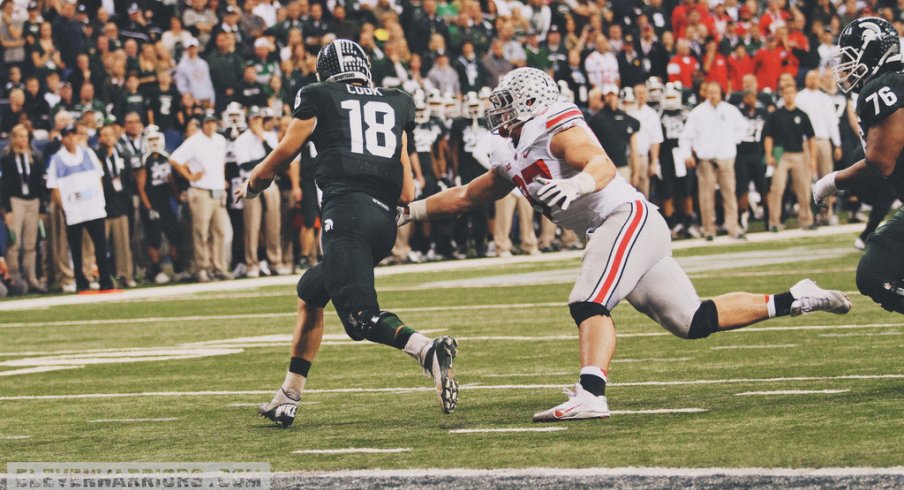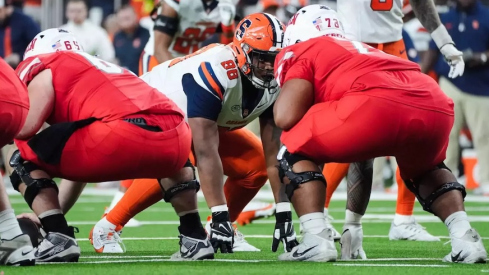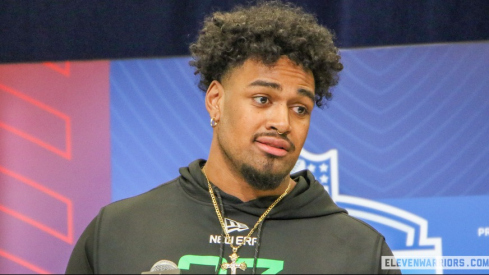November 8th has been circled on many of our calendars for some time.
As the Big Ten continues fall further into the shadow of other conferences, this year’s meeting between Ohio State and Michigan State offers college football fans across the country a reason to pay attention. Though Nebraska currently sits above the Buckeyes in the CFB Playoff poll, many consider this to be a marquee matchup featuring the two premier programs in the conference, looking for a replay of an epic fight for the league crown that came down to the wire last December.
Often defined in the past by their dominant defenses under head coach, Mark Dantonio and longtime coordinator, Pat Narduzzi, the 2014 Spartans continue this proud tradition with a stifling defense headlined by the reigning Big Ten defensive lineman of the year, defensive end Shilique Calhoun.
But this year, the Spartan offense has actually outperformed their counterparts on the other side of the ball. Led by senior quarterback, Connor Cook, the Michigan State offense sits fifth nationally in scoring offense and tenth in total offense, closely resembling the numbers put forth by Ohio State. Unlike the Buckeyes though, who stumbled against Virginia Tech and Penn State, the Spartans have shown little trouble moving the ball at any point this fall, gaining over 420 yards in every game thus far.
Perhaps most impressively, they’ve maintained an excellent balance in play calling, proving to be equally proficient both rushing and passing. Of their 4,122 yards gained thus far, they’ve only gained 44 more yards through the air than on the ground.
If not for an early season slip up against Oregon in which they gave up an uncharacteristic 46 points and nearly 500 yards to the Ducks, the Spartans would be coming into this game unbeaten and likely fighting for a spot in the playoff. Instead, both teams have an equal amount to lose in Saturday’s matchup in East Lansing, as the winner has a fairly easy road to a conference title and potential playoff berth, with the loser looking for New Year’s Eve plans in Orlando or Tampa.
Offense
In his third year under center, Cook has taken the step to being one of the top quarterbacks in the country, possessing a number of traits that NFL scouts will undoubtedly find desirable. Operating from what many consider a “pro-style” offense (meaning the quarterback doesn’t run), the Junior from Hinckley, Ohio has thrown for over 1,800 yards and 17 touchdowns, to only five interceptions.
Though he doesn’t rank among the nation’s leaders in either category, thanks to a number of blowouts and balanced game plans, he has proven to be extremely efficient, with the nation’s seventh-highest quarterback rating. While he still slightly trails J.T. Barrett, Cook still ranks above top quarterbacks like Dak Prescott, Brett Hundley, and Jameis Winston, proving he can hang with the best.
Cook benefits from a great running game, anchored by senior running back, Jeremy Langford. Often overshadowed by other backs in the conference like Ameer Abdullah and Melvin Gordon, as well as his predecessor, Le’Veon Bell, Langford continues to put up big numbers. With 841 yards and 10 touchdowns through eight games, he is coming off the best performance of his career, where he put up 177 yards and three touchdowns against the visitors from Ann Arbor.
As you’d expect from a “pro-style” offense, the Spartan running game leans heavily on the inside and outside zone, as well as the “Power-O” concept, formerly known as “Dave.” It’s true, that former OSU punching bag offensive coordinator, Jim Bollman is now heavily involved with the game-planning in East Lansing. However, the plays are called by co-offensive coordinator, Dave Warner, meaning the MSU play-calling is much more constrained than what we saw in Columbus in 2011 when Bollman had full control.
Warner and Bollman like to keep Cook under center more than most college teams, but will still keep teams off balance, using unbalanced lines and running to the weak side of the formation. Additionally, they like to use motion with their receivers a great deal, looking to force defenders to swap responsibilities just before the snap.
Against Nebraska, the Spartans effectively ran a one-back “Power” play for a 31-yard touchdown by loading the formation to the left, including bringing the right receiver in motion for a fake handoff. Once the cornerback follows across the formation, the Cornhuskers are outnumbered to the play-side, where the Spartans had pulled the left guard to lead Langford through the hole.
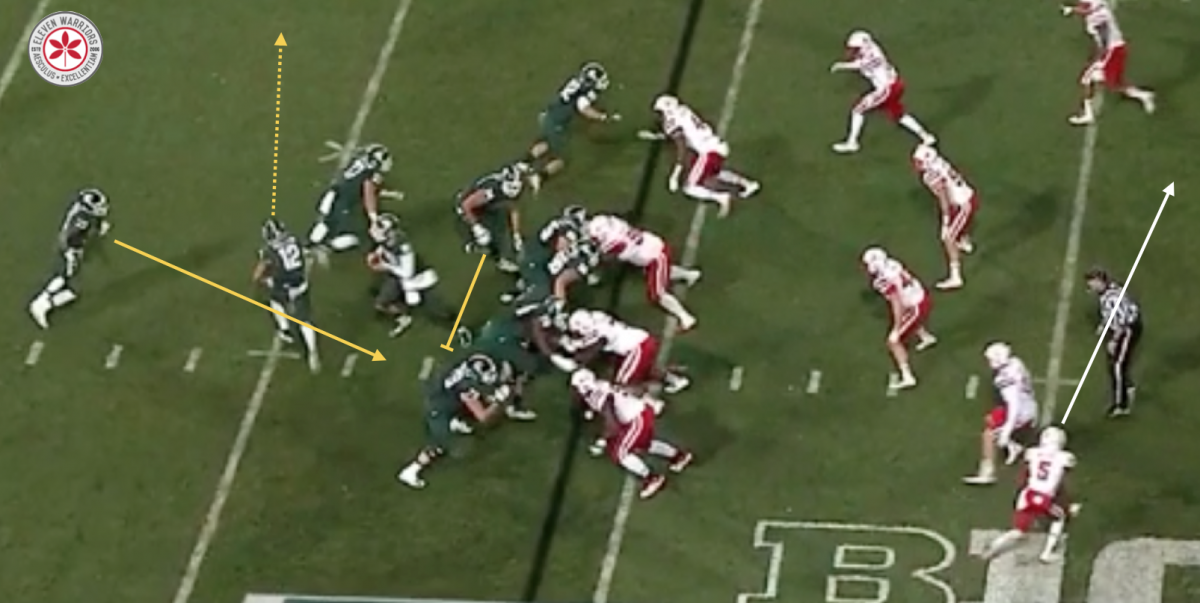
Although they feature a veteran offensive line in terms of age, the Michigan State offensive line contains three first-year starters. This group has gelled quickly however, allowing only five sacks this season, the third-highest mark in the country. But they’ve yet to face a defensive front as physical or as talented as the Buckeyes.
With two new starters at both guard spots, as well as two players rotating at right tackle, one would guess that Joey Bosa will spend the majority of the evening lining up all over the line, looking to find and exploit weaknesses as well as create confusion for any players looking to double-team him.
To help avoid such pressure, Warner and Bollman use a great deal of play-action with designed quarter and half-rolls for Cook, looking to get him away from pressure without having to rely too much on his legs. The Buckeyes must be able to pressure Cook, as he has proven to be extremely accurate when able to set his feet properly.
Cook’s favorite receiver has easily been senior, Tony Lipett, who easily outpaces the rest of the conference in yards and touchdowns catches. Not only has Lippett broken defense for a number of big plays, but has done so in the biggest moments, proving to be Cook’s safety blanket. Against Oregon and stud cornerback, Ifo Ekpre-Olomu, Lippett caught 11 passes for 103 yards.
Like the rest of the Michigan State offense, Lippett is extremely well-coached, running great routes and catching the ball away from his body. Though they’ve faced some good receivers in the form of Stefon Diggs of Maryland, Daesean Hamilton of Penn State, and Leonte Caroo of Rutgers, Lippet offers easily the biggest test of the year for Doran Grant and the OSU secondary.
For those that don’t recall, Lippett torched Buckeye safety, C.J. Barnett with a double-move for a 33-yard touchdown in the 2013 Big Ten championship game, and will undoubtedly look to do re-live that moment Saturday.
Beyond Lippett though, the Spartans have seen few additional playmakers emerge in the passing game. Though tight end, Josiah Price has caught four touchdown passes, he has rarely been much of a threat outside of short-yardage and goal-line situations.
If there is an Achilles heel to the MSU offense, it’s their over-reliance on Lippett, and the Buckeyes must force the other receivers, like Aaron Burbridge and Keith Mumphery, to beat them. Though Chris Ash seems to have successfully installed the Cover 4 coverage scheme with this unit, this may be the week that the Buckeyes call for more Man-2 coverage, allowing Doran Grant and Eli Apple to play man coverage with the help of a safety over the top to help in case of a deep ball.
Additionally, though Cook possesses a strong arm with great accuracy, he has become a bit too confident in his abilities at times, forcing the ball into tight windows that aren’t really open. The Buckeyes will have opportunities to create turnovers, and in such a close matchup of talent, they could easily be the difference between a win and a loss.
Defense
As Ross pointed out, the concepts and techniques used by the Spartan defense have been well chronicled at great length by both he and I (and elsewhere). Dantonio and Narduzzi once again feature a unit that is both fundamentally sound, and aggressive.
Though Calhoun is the headline player of the 2014 squad, the Spartans are built around players like safety Kurtis Drummond (#27) and linebacker Taiwan Jones (#34). Both players are heavily involved in the run game, with Drummond often coming down from his safety position into the box to lead the team in tackles.
Unlike the 2013 unit though, this version of the Spartans lack experience at a couple of key positions, starting two new defensive tackles and a cornerback.
Junior, Lawrence Thomas (#8) takes over at nose guard, marking the end of a long journey that saw him start as the top linebacker prospect in the nation, with stops at fullback and defensive end along the way. The former blue-chip prospect continues to learn the position, and like fellow new starter, Joel Heath (#92), has yet to make much impact.
In the past, Narduzzi has had players up front like Jerel Worthy and William Gholston that could physically dominate an opponent and cause problems in the running game. This year is different, as even though Calhoun is a playmaker, he’s much more of a classic pass-rushing end, relying on quickness to get in the backfield, and six of his eight tackles in the backfield this year have been sacks. The other starting end, the aptly-named, Marcus Rush (#44) has turned into a very solid player in his senior year, but also lacks the power to clog up running lanes.
To make up for this lack of size, Narduzzi has had to rely more than ever on his famed, Double-A gap blitz. The numbers back it up, as Jones and linebacker Ed Davis (#43) lead the team in tackles-for-loss, many of which have been against the run.
If OSU is able to move the ball well with the inside run game, Narduzzi will undoubtedly call for the blitz, with Drummond looking to fill in the vacated middle behind them. To make up for Drummond coming up to help fill, the other three secondary players shift to a three-deep zone coverage, opening all kinds of gaps on the edges and in the middle.
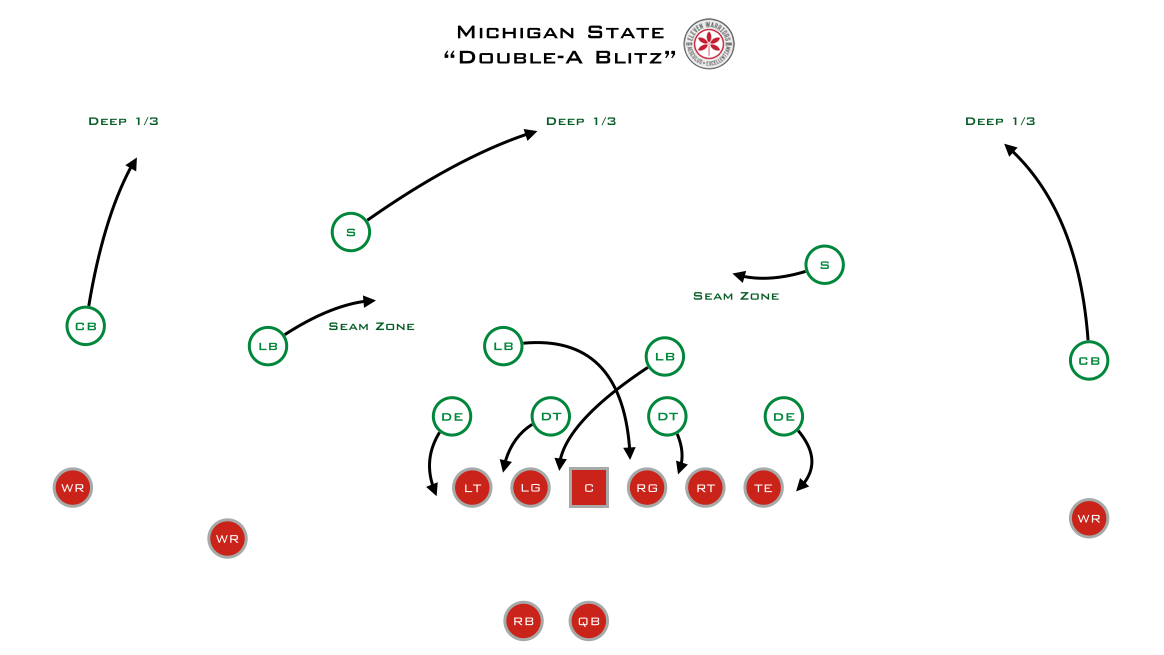
Virginia Tech shut down the Buckeyes in a similar way, looking to take away the inside running game and deep ball off play-action, but Barrett and the OSU offense has shown an ability to take these open zones since. Additionally, much like Michigan State offered this blueprint last year as a way to beat the Buckeye offense, Oregon may have shown how to take apart the Spartans defense.
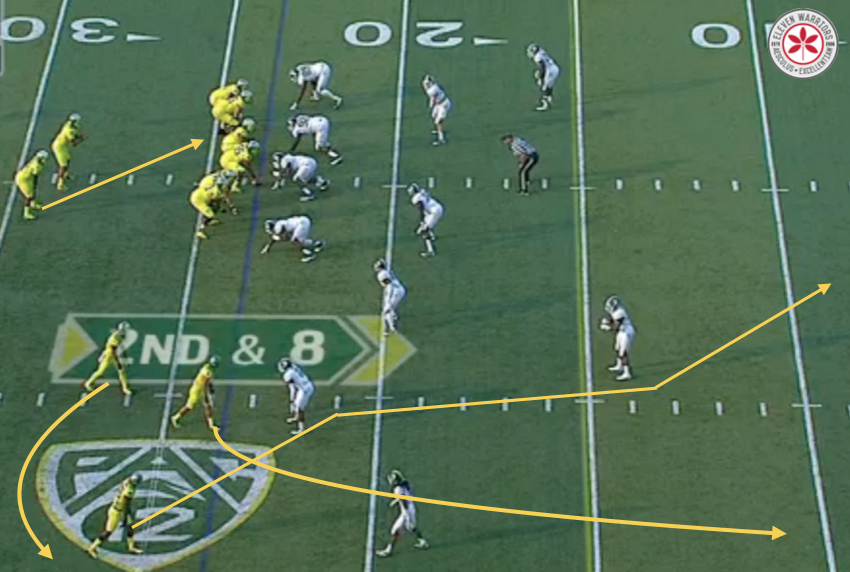
By over-loading one side of the field, the Ducks have forced MSU into an adjustment in coverage, with both corners to one side. In case of any press coverage, which is shown by new starting cornerback, Darian Hicks (#2), the Ducks attack with a “switch” route, where the two receivers switch roles after the snap, with the outside receiver running inside, and vice versa.
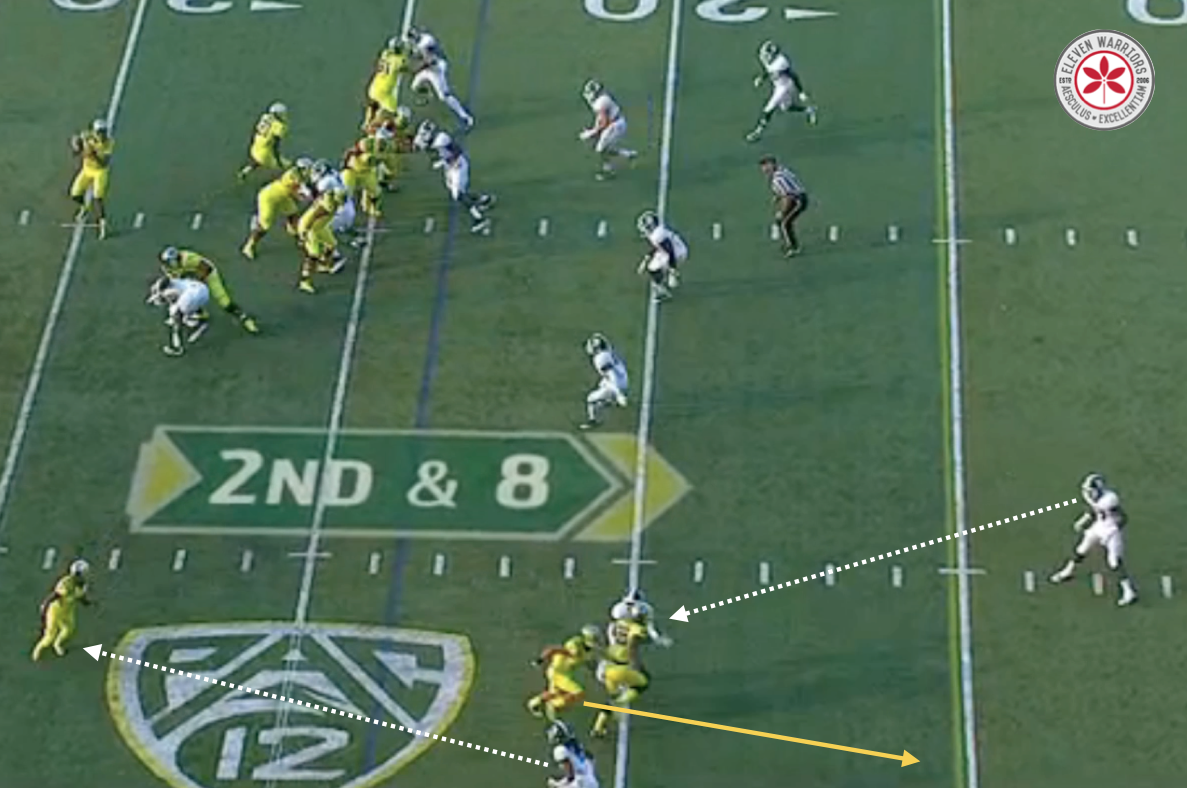
Though the Safety, Drummond recognizes the in-breaking receiver, Hicks is stuck behind a natural pick from that same receiver, and unable to recover in time. To ensure the outside corner doesn’t drop back to help, the Ducks included a short screen route to the third receiver to the side, ensuring he must stay in his zone to account for that. The result was an easy, 23-yard touchdown pass.
On the very next possession, Oregon would use a similar set of tactics, this time to open up the “all verticals concept.
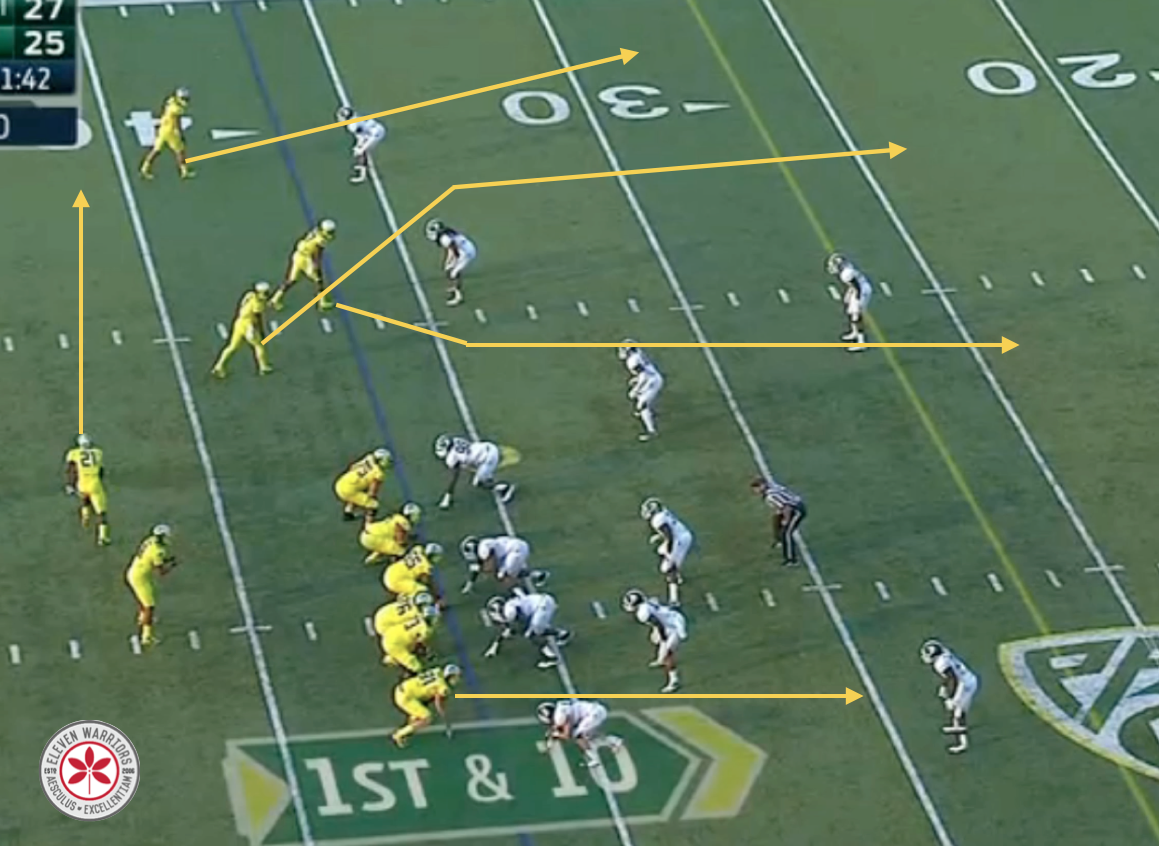
Not only were the Ducks able to get a free release for one of their inside receivers, the threat of the swing pass to the running back sucked a defender up, leaving Drummond with the unenviable task of picking which receiver to cover deep, leaving one wide open for another easy throw.
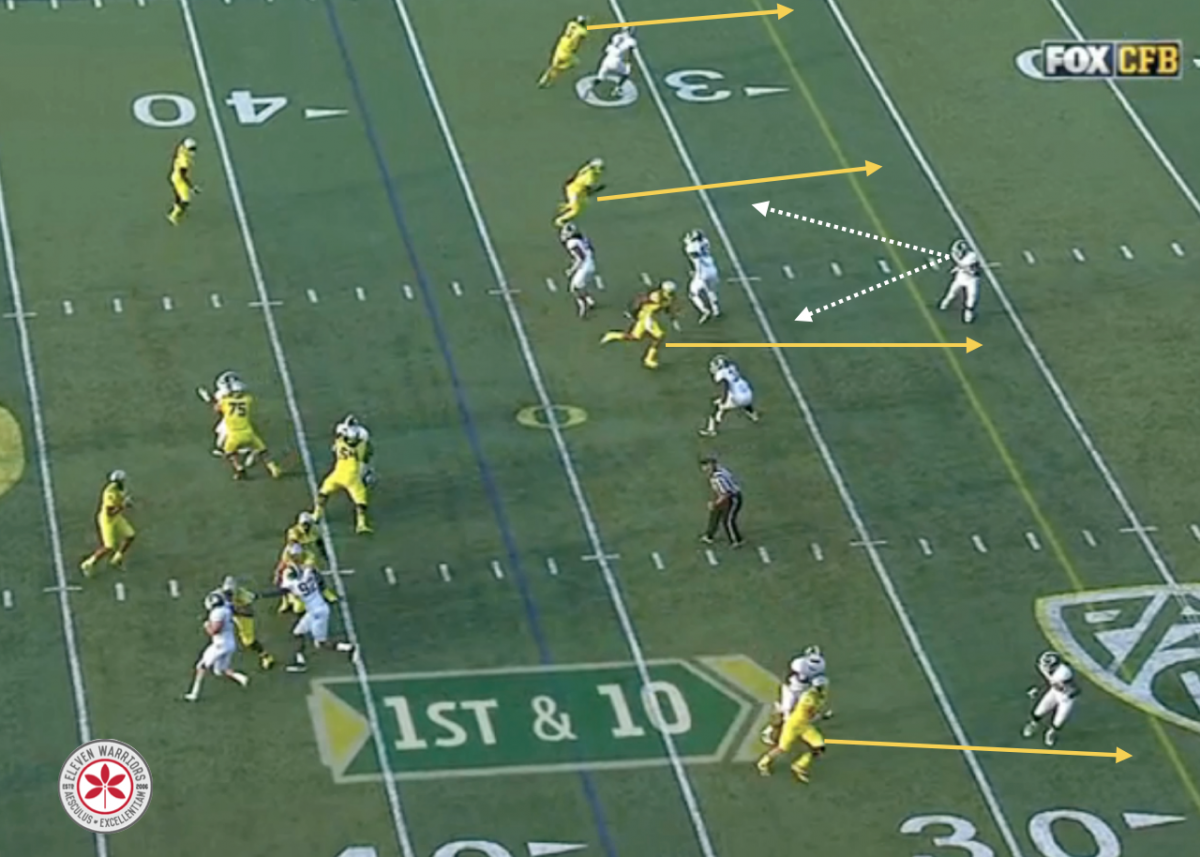
The OSU receivers were a virtual non-factor in last year’s matchup with MSU, as well as in the loss to Virginia Tech, mainly due to the press coverage both teams exhibited at the line. There are definite keys the Buckeyes can take from what Oregon did that will fit in line with what the Buckeyes already do well.
Packaged receiver screens with inside runs could be deadly against the Double A blitz, as the Buckeyes would have a huge numbers advantange on the edge.
The Buckeyes must be willing to dial up these concepts with such a young team of their own, though. The conservative play-calling near the end of the Penn State game will allow MSU to attack straight ahead, which is exactly what they do best.
But ultimately, this game will come down to execution more than schemes. With little gap in overall talent, the individual battles on the line or between a receiver and a cornerback are so much more important. OSU can’t afford turnovers, penalties, or missed plays, as the team that makes the fewest mistakes will likely come out victorious.
The Spartans are a complete team with virtually no major holes. It's up to the Buckeyes to find the areas where they're simply better, and look to exploit them.
